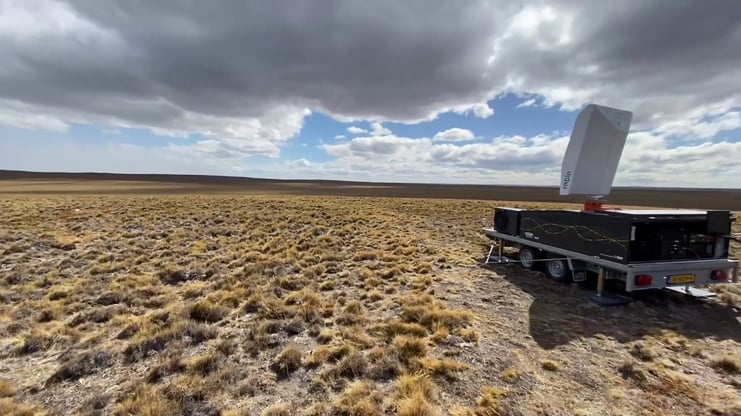Every year the world comes together to celebrate World Migratory Bird Day (WMBD), a poignant reminder of the incredible journeys undertaken by millions of birds across the globe.
From the Arctic tundra to the African savannahs, and everywhere in between, migratory birds navigate vast distances, facing numerous and evolving challenges along the way. The advancing development of human infrastructure is one of them.
Wind turbines pose a severe risk to migrating birds. Due to an increasing lack of space, the most effective wind farm sites often overlap with migration routes.
In this blog, we examine the significance of migrations and the innovative role of radar in ensuring safe passage through wind farms.
The role of avian radar at wind farms
Innovative bird detection radars combine precision hardware with intuitive software, empowering operators with full awareness of everything happening in and around their site. In MAX, accurate tracking means 3D, 360° awareness, all year round.
Avian radar is an effective tool in gathering key data on both local and migrating birds. It detects altitude, bird number, size and flight path, tracking thousands of birds simultaneously. Operators use these insights to develop ecologically conscious sites.

Migration thresholds, the number of birds that classify a high peak migration, can also be set by operators. Once these parameters are passed, radars like MAX can send a signal to the turbine control system to ensure safe passage.
This shutdown-on-demand (SDOD) signal is based on real-time data, so single or groups of turbines can be deactivated rather than the entire site, which minimises downtime.
Once the migration has safely passed, the turbines then reactivate, preserving energy production and protecting wildlife.
Trailblazers in turbine shutdown
On May 13th, 2023, the whirl of an offshore wind farm near Borssele and Egmond aan Zee slowed to silence.
The turbines had stopped, for the first time, to allow the safe passage of a massive predicted migration. The University of Amsterdam developed the predictive model using data collected by our bird detection radar, MAX.
Climate Minister Rob Jetten said: “This is an international first; nowhere in the world have offshore wind farms been shut down to protect birds during mass migration. We want to keep the impact of wind farms on nature as small as possible and we do this, among other things, with this measure.”
Using weather and bird radar, UvA researcher, Maja Bradarić, produced the prediction model that forecasts migration intensity two days in advance. This kind of warning gives grid operators time to guarantee the stability of the high-voltage grid and initiate shutdown protocol.
As a result, from autumn 2023 wind farms are being shut down more frequently to protect migratory birds in the North Sea.
Why bird migration matters
Annual migration involves the relocation of millions of birds each year, as they travel between new breeding and wintering grounds.
Migratory birds indicate the health of our planet, and their voyages are essential to ecosystems worldwide. Their movements are intricately linked to the changing seasons, the availability of food, and the quality of habitats.

Roughly 4,000 species of birds regularly migrate, which amounts to 40% of the total bird population worldwide. By monitoring their migrations, scientists gain valuable insights into the state of our environment and the impact of human activities, such as the advancing development of wind farms.
The pace of wind farm developments promotes a brighter future for our global energy mix, however, it threatens migratory birds and their essential routes.
If poorly sited or ineffectively monitored, turbines create severe problems for migrating birds.
Wind farms and bird migrations
Wind turbines have become the recognised giants of renewable energy, and while they conserve in one sense, their unyielding turn puts elements of the natural world in danger.
Turbines are confusing for birds, who struggle to negotiate the spin of the blades and may not see them at all. Large species, including critically endangered species, are at particular risk of collision.
If birds do spot turbines, altering their routes to avoid them can also spell disaster. These long journeys and the energy they cost have been finitely calculated against rest and food stops. A migration that costs birds more time and energy could adversely impact breeding and nesting patterns.

Wind farms also often require infrastructure, such as access roads and transmission lines, which can fragment habitats and disrupt important stopover sites.
Wind farms could even indirectly affect migratory birds by causing decreased numbers of prey species. When prey, such as insects or small mammals, are displaced by wind farms, migratory birds could face food scarcity.
Innovation that preserves life
Wind farms are essential for the green energy transition, and their development doesn’t have to spell trouble for migrating birds. Not if we strike the right balance.
Today we pause to marvel at our world’s migrating birds and their incredible journeys and to thank our partners, customers and supporters for working hard to understand and protect them.
Researching the effects of human activities and infrastructure on the natural world is integral to setting up protocols that protect it.
We designed MAX to be a durable, versatile and intuitive tool for ecological research, deploying in remote locations all over the globe.

Robin VP Wind and Environmental Practice, Sibylle Giraud, said: “I joined Robin in 2018 to expand our scope and create a team that fully focuses on the wind and environmental segment.
“It’s been an extraordinary journey over the last five years, seeing our flagship system, MAX, gradually deployed worldwide. What I love the most is the passion within the industry to keep finding ways to protect birds and bats.
“Protecting the balance between human society and the natural world is becoming even more of a challenge. However, the pace of innovation is accelerating in every corner of the planet. Radar application is surging in important ecological studies.”


